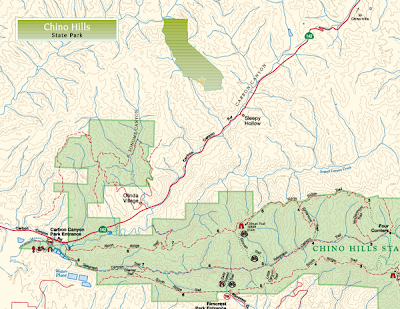Chino Hills Sate Park is a unique park that is both biodiversity and solitude to the visitors who enjoy their outdoor experiences. There is no other location in the LA Basin where people can drive a short distance and be swept away with scenic vistas, hike, bike or ride a horse on over 65 miles of trails.
At 14,102 acres the park is managed as an open space habitat where all plant and animal life are protected.
Chino Hills State Park, a premier natural open-space area in the hills of Santa Ana Canyon near Riverside, is a critical link in the Puente-Chino Hills biological corridor. It encompasses stands of oaks, sycamores and rolling, grassy hills that stretch nearly 31 miles, from the Santa Ana Mountains to the Whittier Hills. Chino Hills is vitally important as a refuge to many species of plants, and as a link between natural areas essential to the survival of many animal species.
Ranging from 430 feet to 1,781 feet in elevation, the park straddles the north end of the Santa Ana Mountains and the southeast portion of the Puente-Chino Hills, which together form the northern end of the Peninsular Ranges in Southern California. This formation interrupts the generally flat Los Angeles Basin with a variety of rolling hills, mountains and canyons on its south and east sides. The hills are a result of uplift and folding along the Whittier and Chino faults.
For humans relaxing or recreating in the park, Chino Hills is an island of tranquillity in a sea of urbanization. For the plants and animals in the park, Chino Hills is a link to other natural areas. Southern California is so heavily urbanized that it is impossible to preserve the huge tracts of land needed to ensure species diversity. However, by providing a major biological link between islands of open space, Chino Hills effectively makes habitats larger.
Chino Hills is also a place where people can escape the pressures of urban life and find peace and solitude in a natural setting. Visitors can camp for a few days or simply enjoy a walk, horseback or bicycle ride over trails that meander through valleys and along ridge tops through woodlands, sage scrub and grasslands. Sixty miles of trails and fire roads also offer excellent opportunities for viewing wildlife and native plants. Facilities consist of a picnic area, equestrian staging area, pipe corrals, a historic barn, water spigots and restrooms. Most of the trails accept multiple use. However, a few trails are designated for hiking only, because of safety issues or the potential for damage to habitat.
Location - Directions
The park is located 10 miles northwest of Corona. Take the 91-Freeway to Highway 71-North, turn left at Soquel Canyon. Proceed to Elinvar and turn left. Elinvar merges into Sapphire on the left, the park entrance is located on the right.
4721 Sapphire Road; Chino Hills, CA 91709; Latitude/Longitude: 33.9198 / -117.7144
The park is located 10 miles northwest of Corona. Take the 91-Freeway to Highway 71-North, turn left at Soquel Canyon. Proceed to Elinvar and turn left. Elinvar merges into Sapphire on the left, the park entrance is located on the right.
4721 Sapphire Road; Chino Hills, CA 91709; Latitude/Longitude: 33.9198 / -117.7144



























